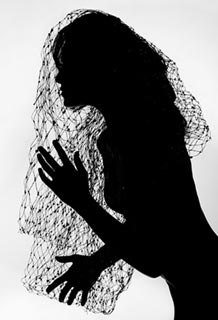
Copyright © Lindsay Adler
This silhouette was created after finding a prop in a local arts and crafts shop. This netting was covered in white sequins and white glitter and was intended to be placed on shrubbery as Christmas decoration. I saw the setting, and thought it had potential to be used in a shoot. Later I was inspired by a silhouette shot created by a famous fashion photographer and did my own interpretation using this netting.
Technical: Canon 5D, 85mm lens, f 5.6, 1/100, ISO 100
Previously, we discussed working with models, getting your inspiration, and gathering a creative team. Now it‘s time to consider some other pieces of the puzzle–including props, backgrounds, and shooting on location.
Props
Props can enhance and/or detract from a fashion image. In general, photographers new to fashion photography should keep it simple. Adding too many props may complicate lighting, posing, and composition. It’s important to master your interaction with the model, conquer technique, and then focus on props/backgrounds to help express your vision. That being said, props can also be extremely useful tools for enhancing the mood of an image or revealing an aspect of the subject—especially in portraiture.
There are several considerations to keep in mind when working with props. Is the prop the central focus of the image or an addition to the overall feel of the image? Is the prop meant to communicate something about the image, or is it a graphic element? The answers to these questions will help you decide the lighting and composition of the image. To what do you want the viewer’s eye drawn–the prop, the model, or the clothes?
Props can be extremely useful for inspiring fashion images and helping you to think outside the box. I find props online (eBay), at thrift stores, antique stores, and arts and crafts stores. When you start to work with more experienced stylists (who manage the clothing and props), they may have access to really bizarre pieces that help make an image appealing. Furthermore, if you’re located in a city, you may find prop houses that can provide interesting pieces for purchase or rental.
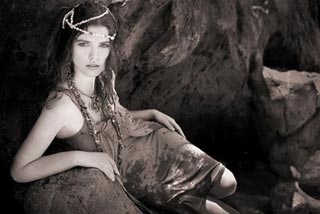
Copyright © Lindsay Adler
This photo was taken in Laguna Beach, California, when I went on a trip to visit my grandmother. I knew I wanted to photograph the model on a beach but wasn’t sure where. The day before the shoot, I visited the beach to find the right spot. I found this rock formation and could see the graphic potential and where the model would fit into the scene. The curves and shapes of the rock were an inviting location for a model to pose.
Technical: Canon 5D, 50mm lens, f 3.2, 1/200, ISO 100
Backgrounds
Deciding on a background for your image is a key part of the creative process and requires you to analyze the artistic goals of the image. Do you want the background to be “quiet”–virtually unnoticed by the viewer? Or do you want the background to be an integral part of the image that either compliments the subject or provides a way for the subject to interact with the surroundings? For example, when I’m doing a “beauty shot” (that focuses on hair, makeup, or the general beauty of the model), I usually want a plain, complimentary background. I find one that’s solid black, white, or gray works best to focus the reader’s eye on the model’s beauty without distraction. For other fashion shoots, I want to set a certain mood with the environment or want a strong composition where the model fits perfectly into her environment. Once you decide what you are accomplishing, you can choose to work either in the studio or on location.
What You Need in a Location
When you decide to shoot on location, what are your visual goals? Do you want to establish a certain mood with the location? Do you want strong graphic elements for your composition or ways in which the model can interact with the environment? Or are you just seeking to play with color and textures?
In the course of my daily life, I’m always looking for great textures and colors–such as decaying walls, brightly colored graffiti, or other elements that could make strong backgrounds for fashion images. For one shoot, a shiny metal garage door might add the coldness or sterility I need. For another shoot, a dilapidated warehouse may provide texture as well as a grittier mood. I also find that some locations just “speak to me.” Some locations may naturally feature graphic shapes or great places to pose a model to create a dynamic image.
Locations can allow you to tell a fictitious story as a fashion editorial. If you shoot on a farm, you could do a fashion editorial with a variety of different twists. One story could simply be about a farm girl going about her everyday chores (and feature natural styling and less avant garde clothing). Another story could be about someone on a farm who’s completely out of place (and wearing really high-end clothing). The variations are endless, and each location provides the potential for a different story.
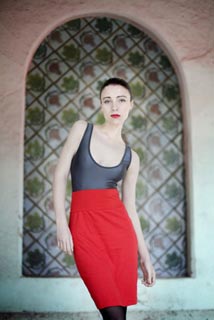
Copyright © Lindsay Adler
I’m always looking for great location in the areas close to where I live. This photo was taken in the park about three blocks from my home. While walking in the park, I saw this detailed archway and thought it could make a beautiful frame and background texture for a fashion shoot.
Technical: Canon 5D, 85mm lens, f 1.8, 1/500, ISO 400
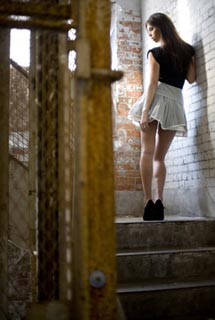
Copyright © Lindsay Adler
The location was an old warehouse in my city that was being converted into an artists’ space. I have photographed many models on location here because of the rich textures of the walls, beautiful window lighting, and interesting structures within the building and their mood of urban decay, abandonment, desolation, etc. This shot was taken in the stairwell and made use of the strong compositional shapes, beautiful lighting, textures and feeling of decay for a strong juxtaposition with the delicate model.
Technical: Canon 5D, 50mm lens, f 1.4, 1/100, ISO 400
Finding Good Locations
Finding a location that’s perfect in some way is an art, and many people are employed in the business of discovering locations. Freelance location scouts make hundreds of dollars a day. In addition, many location companies have huge databases of shooting locations divided into dozens of themes (such as interiors, gardens, derelict buildings, and more). These companies (often used by TV and film productions) charge a fee for use of their databases and then help you negotiate a location rental fee with the owner of the site. If you have a lot of expendable income, this is an option, but in general, these databases are used only for higher-end fashion and editorial shoots.
The Internet is a great resource for locations. For example, if you’re looking for a place that says nature or woods, you can search online for forests, woods, botanical gardens, and parks in your vicinity. You can seek any type of location. For instance, when I needed to do a dark, gothic shoot, I searched online for local funeral homes and called until I found one that was willing to lend me their location and casket for the day.
We often imagine exotic locations and neglect the great opportunities available in the immediate area. You should take advantage of locations unique to where you live. If you live in a rural area, try shooting in the woods, on a farm, in a local garden, forest, or historic building. If you live in a city, try looking for derelict buildings, public parks, in bars, clubs, or hotels. If you look around you with an open mind, you’re sure to be surprised at the variety of interesting shooting locations you discover. Because my mobile phone has a camera, I can quickly snap a picture of a location to remind me later.
Finally, if you do have an opportunity to travel to an exotic locale, take advantage of the occasion. Whenever I visit relatives near the beach in California, I use my connections on model networking sites (like Model Mayhem) to set up test shoots on the beach and local parks.
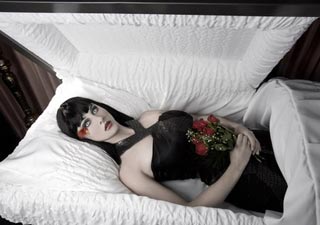
Copyright © Lindsay Adler
I was photographing a collection for a designer whose theme for her pieces was dark, mourning brides. She felt that it might be interesting to have the models shot on location at a cemetery or in a funeral home. Using the Internet, we called up various funeral homes in the area until we found one willing to lend us a casket and their space for an afternoon.
Technical: Canon 5D, 50mm lens, f 8, 1/100, ISO 200
Other Location Considerations
Shooting on location can be tricky. Will the weather affect your ability to shoot? Does your shot require artificial lighting (and is power available)? Is there enough space to light the way you want?
Many locations–including public sites–may require permits and prior permission, and many will ask you to pay large fees to use their space. Always check before the shoot, because there have been endless incidents when photographers have been sent away from a location because they didn’t obtain prior permission. Always be sure to mention when you aren’t shooting for pay or commercial use–for example, if you’re simply building your portfolio. To negotiate, offer images as incentive, and if you’re a student or belong to any photographic organizations, be sure to mention that, as well.
Lastly, you may need to consider carrying some form of liability insurance for shooting on location. Many wedding and portrait photographers have insurance to protect them in the event that someone is hurt as a result of the shoot (model, passerby, etc). If a model is injured or a light stand falls and breaks something, you could owe a lot of money, so you may want to discuss the different protections available with a lawyer and/or an insurance agent. Another solution that I use is to have the model and other participants in the shoot sign a waiver that says I’m not liable for any damage that may occur to them or their property on a shoot. (Sample releases can be found online and can also be discussed with a lawyer.)

Copyright © Lindsay Adler
Cover Photo: This photo is an example of how to continually look for locations. I was doing a portrait of a local art student in the printmaking studio at her university. I noticed a room that said “Spray Paint” on the door, and I asked to take a look inside. I found this location and snapped a quick picture with my camera phone. I didn’t have a specific shoot planned immediately, but nearly a year later, I met a designer who had a graffiti-inspired dress, and we able to use this fabulous location.
Technical: Canon 5D, 16mm lens at 24mm, f 6.3, 1/125, ISO 100, beauty dish
Don’t let the potential problems that accompany shooting on location stop you from going ahead. Some of my favorite, most stunning images have been shot on location. With the proper combination of model, clothing, location, and lighting, you can create striking original images that establish a unique mood to the photo. You can also use locations to tell great fashion stories that draw your reader into the experience and aesthetic of your model.
by Lindsay Adler

Leave a Reply